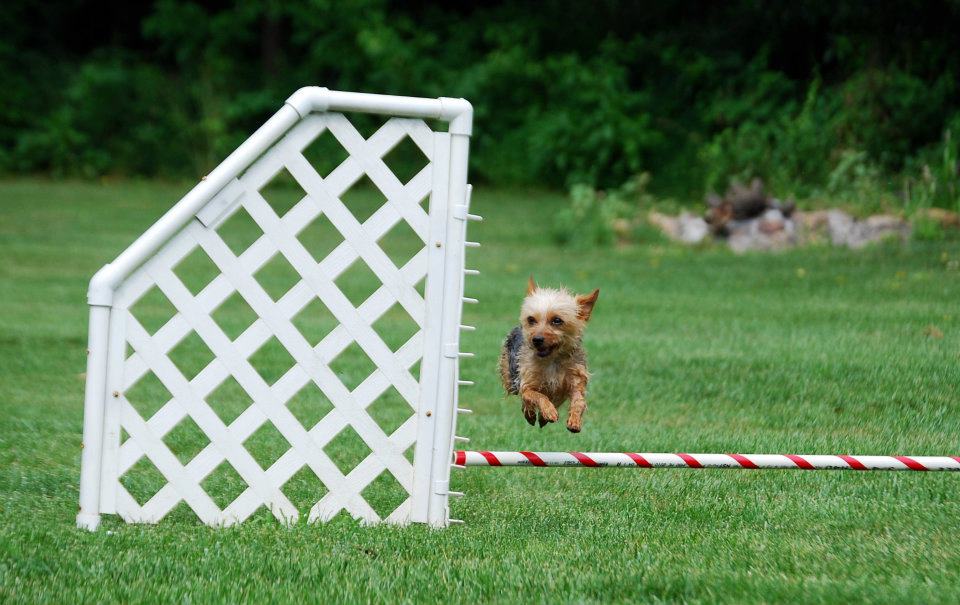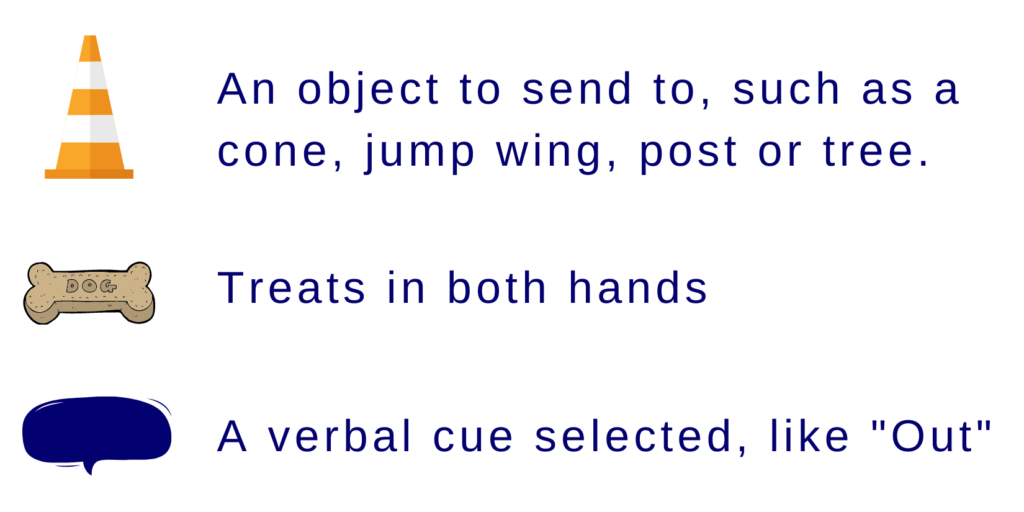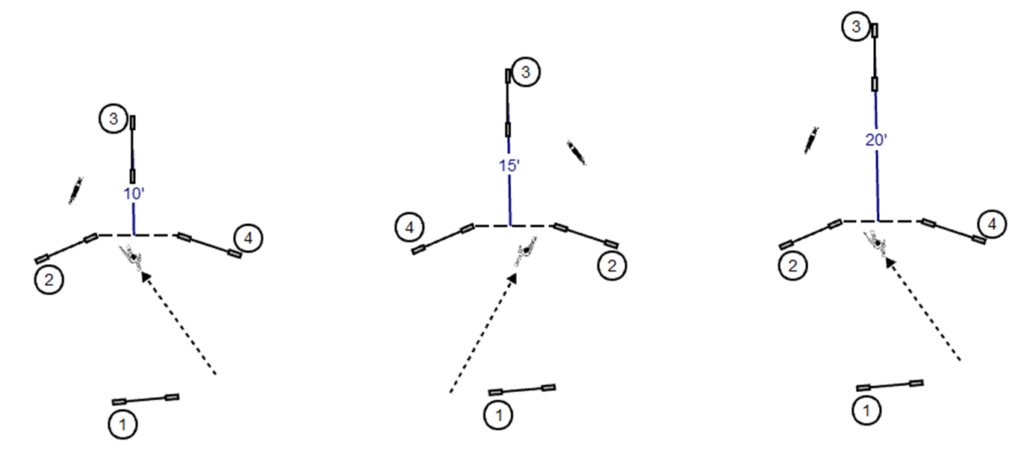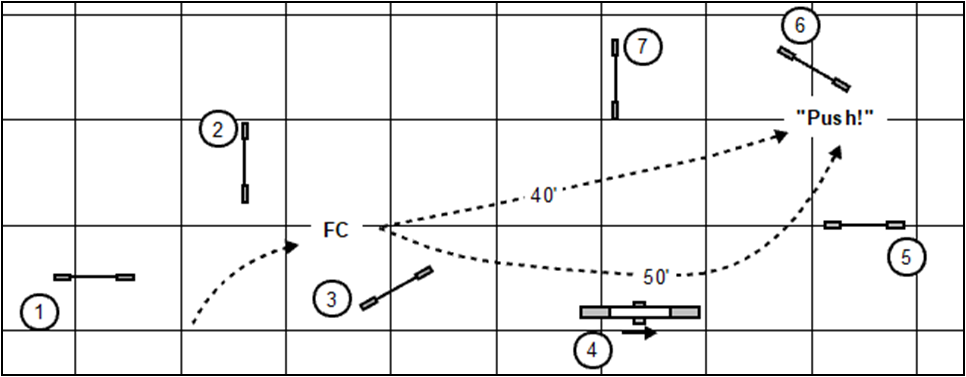This page features information on distance training and handling. You’ll find foundation drills, short sequences, handling advice and more.
Sign up for our newsletter to stay up-to-date on new resources.
Training a Distance Send
A distance send is where the dog is cued to go away from the handle to take an obstacle. This allows the handler to get ahead on course for crosses and to handle technical challenges.
This cue is not for a “send to the backside” of a jump, instead a distance send is used most often on pinwheels and tunnels.
Distance sends are also essential for games competitions like Gamblers or FAST classes. And, they help you get ahead and stay ahead on course.

Before you can use distance sends on full agility courses, you need to train your dog a cue that means “go out to an obstacle”.
The following drill helps introduce and reinforce this behavior.
You’ll need to pick a verbal cue, we use “Out!” for this behavior. Alternatively, you can use “Away” or “Around”. You’ll also use body language to cue this behavior. The arm closest to your dog will be raised and pointed to the obstacle you’re sending to, and you’ll take one definitive step that direction too. These body cues support your dog’s performance of the distance send.
To train this “Out!” send drill, you’ll need:

To do the drill:
1. Have your dog sitting or standing at your side within 2ft of the object you’re going to send the dog around.
2. Step forward with the leg closest to your dog and raise the arm closest to your dog. And, say “Out” as you guide your dog around the object.
3. Mark the success when your dog commits to going around the object. This mark can be with a clicker or a verbal “Yes!”
4. Reward with a treat from your hand after your dog goes around the obstacle.
After a few successful repetitions from the left and right hand, gradually increase distance. Keep your dog successful; they need to be confident in their ability to do the task to complete an independent behavior like a distance send.
Cueing A Distance Send
A combination of handling cues can be used to cue a distance send; this includes your foot placement, hand signal and verbal cue.
When you practice and reinforce your distance send with proper cues, you increase your dog’s confidence and their overall ability increases. In other words, after practice your dog will be able to commit taking an obstacle from farther away than before.
Using consistent cues can also be supportive of the skill when its in action on course. If your dog second guesses their path, your cues will let them know that their path is correct. I always tell my students, the more distance you use the more time you have to support the dog’s performance.
Distance Sends in a Pinwheel
Using your distance send in short sequences can help you and your teammate learn to move through basic agility patterns with ease.
For example, practice using your distance send in a simple pinwheel sequence.
This is helpful as pinwheels are a common agility sequence seen in every agility venue. A pinwheel tests your dog’s distance skills as the distance between dog and handler may increase as the dog progresses through the pinwheel. The course flow may also require the handler to increase their distance away from the dog, such as running ahead for a crosses while the dog completes the pinwheel.
While most agility teams can complete a pinwheel with 5ft to 10ft of distance, additional training can increase your dog’s working distance and your handling options.
Pinwheel Distance Progression
Try out the sequence progression below.
As your dog succeeds, increase the distance of your send. The handler should not cross the dashed line between jumps 2 and 4 to ensure the dog is working independently and at the intended distance.

Troubleshooting?
If your dog is having trouble committing to a distance send in pinwheel, watch the below video of Flash training distance on the pinwheel. You’ll see me break down our distance send after she has fails to send out to the jump.
You can use a different reward placement to reinforce and improve your dog’s distance send.
Reinforcing Lateral Distance
Lateral distance is important for handling with distance. This allows you to be parallel to your dog on course, often making your path shorter than your path! This is a huge advantage to dog-handler teams with a speed ratio where the handler moves slower than the dog.
To do the drill
Set up two obstacles in a straight line, like the tunnel and jump shown below.
Your training goal is to show your dog what it looks like to stay at a distance versus when you want them to come closer to you. At a distance, place the reward ahead and cue your dog “Go!” ahead to parallel your path while staying at a lateral distance.
Begin gradually adding distance as your dog succeeds, going from 5ft lateral to 15ft lateral or more.
Once your dog has a few successes, ask them to come to your side after the first obstacle instead of continuing on their path lateral from you. This will help show the dog what each behavior – maintaining distance or coming to you – looks and sounds like. By juxtaposing these two cues, you give your dog the ability to use your body language and verbal commands to understand where they should go next.
Don’t correct your dog if they ignore your “come” cue. You just heavily reinforced staying at a distance, give your dog time to listen and think about which cue means what. On your next attempt, call them sooner and move your body to help them.

Reward Ahead while paralleling your dog’s path (left image)
Reward at your side while asking your dog to come to you (right image)
Handling Point to Point
When handling with distance, you want to be as intentional with your handling path as you are setting your dog’s path. Wasting yardage on your handler path puts you behind and can force you to alter your handling plan mid-run! During your walk-through, consider what handling you need to do and then run a direct path – if possible – from handling point to handling point.

Handler goes directly from their Front Cross (FC) to the Backside Send (“Push!”)
If handling with distance is already your style, you’re ready to apply this handling concept to sequences, like the one shown above! For teams just beginning to work at distance, consider reinforcing your lateral distance and rewarding your dog’s obstacle commitment before handling with distance in sequence. Handling with distance requires the dog to be able to complete obstacles independently.
